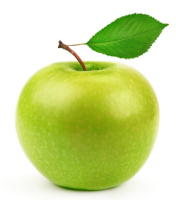Apples
 Has there been a fruit with a more exciting past than the apple? From the Garden of Eden to the tale of Snow White, the apple with its delectable taste has been one of the top fruit choices for young and old alike.
Has there been a fruit with a more exciting past than the apple? From the Garden of Eden to the tale of Snow White, the apple with its delectable taste has been one of the top fruit choices for young and old alike.
Overview
The old adage to consume "an apple a day" is not a bad idea. Apples can help control diabetes, prevent constipation, lower the risk for heart disease and help to prevent cancer.
While many people prefer the flesh of the apple, the skin contains much of the apple's healing power. The apple skin has about 4 milligrams of quercetin, an antioxidant compound that helps prevent damage from free radicals.
History
The first apple trees are thought to have come from southwestern Asia and eastern Europe. Apples are now found in many regions of the world with moderate climates for growing seasons. Due to hybridization and modern cultivation techniques, a wide variety of different apples find their way into the marketplace.
Apples have long been the theme of not only biblical tales but also mythical ones. Norse mythology states that apples had the ability to keep a person young forever. While many of the tales were fiction, the legend of "Johnny Appleseed" was about the life of a real individual (John Chapman). In the 1800s Chapman travelled more than 100,000 square miles planting apple trees. This barefoot philanthropist thus provided food and livelihoods for many generations to come.
Nutritional Information
Many people do not know that apples are a good source of potassium. This fruit is also an excellent source of fiber, pectin and vitamin C. Apples differ from some other fruits (such as oranges) by having many of their most important nutrients contained in their skins.
In their raw and unpeeled state, apples provide important phytochemicals such as flavonoids (particularly quercetin) and ellagic acid. Fresh apples contain around 100-130 milligrams per 100 grams of chlorogenic, ellagic and caffeic acids. When apples are cooked, this content is nearly destroyed.
One small apple provides a 100 gram serving with 52 calories, 0.2 grams of fat, 3 grams of fiber and 12.8 grams of carbohydrates. A 100 gram serving of dried apple has an amazing 450 milligrams of potassium. The average apple also contains 0.7 grams of pectin, more than the pectin found in bananas and strawberries.
Health Benefits
People who routinely consume apples have a reduced risk of asthma, cancer, heart disease, and type 2 diabetes when compared to individuals who consume other vegetables and fruits. In one Finnish study of more than 5,000 women and men over more than 20 years, the study participants who ate the most apples and other foods rich in flavonoids (such as tea and onions) had a 20% lower risk of heart disease. Another study showed those who ate large quantities of apples had a lower incidence of asthma. A similar study in the UK showed those who ate at least two apples per week had at least a 22% less chance of developing asthma.
Along with the quercetin, today's scientists believe the health benefits of apples are due in large part to their flavonoid content. Apples also contain a lot of pectin, which is a soluble fiber with many beneficial qualities. Pectin forms a gel-like material while in the digestive tract that helps to lower cholesterol. The gel slows down digestion, in turn slowing down the rise in blood sugar - a good choice for people with diabetes.
Quercetin has shown in laboratory studies the ability to help prevent cancer cells from spreading and to inhibit the growth of tumors.
The insoluble fiber and pectin found in apples helps to relieve constipation and diarrhea by promoting regularity in the bowels. Kaopectate, a well-known remedy for diarrhea, contains a type of pectin.
Safety
Because a variety of insects attack apples during their growing season, apples contain more pesticide residues than many other foods. Organically-grown apples should be thoroughly washed using cool water. Nonorganic apples should be washed with a solution of additive-free soap or a commercial wash specifically for produce.
When buying dried apples, avoid those products containing sulfites or sulfurdioxide.
As apple seeds contain very small amounts of cyanide, many experts recommend coring the apple to remove the seeds before eating or cooking, even though the amounts of cyanide are very small.
Selecting and Storing
Top quality apples should be crisp, firm and have a good color. When overripe, apples will feel soft when pressure is applied to the skin.
All apples should be thoroughly washed and rinsed before storing.
Serving Ideas
Apples are best eaten raw with the skins to obtain the most nutrients. They can also be enjoyed by:
- Adding diced apples to salads.
- Lightly sauteing apple slices with one diced onion and one diced potato.
- Skewering apple slices on cinnamon sticks and bake for 25 minutes in a 350 degree oven.
- Snacking on apple slices and cheese.
References
- Holford, P.(2004). The optimum nutrition bible. London : Piatkus
- Holford, P & Lawson, S. (2008). Optimum Nutrition Made Easy How to achieve optimum health. London : Piatkus
- Murray, M.T. et al.(2005). Encyclopedia of healing foods. London : Piatkus
- Yeager, S. & Prevention Health Books. (1998). The doctors book of food remedies : the newest discoveries in the power of food to cure and prevent health problems from aging and diabetes to ulcers and yeast infections. [Emmaus, Pa.] : Rodale
Posted in Apples
Ask a Question Or Join a Discussion


